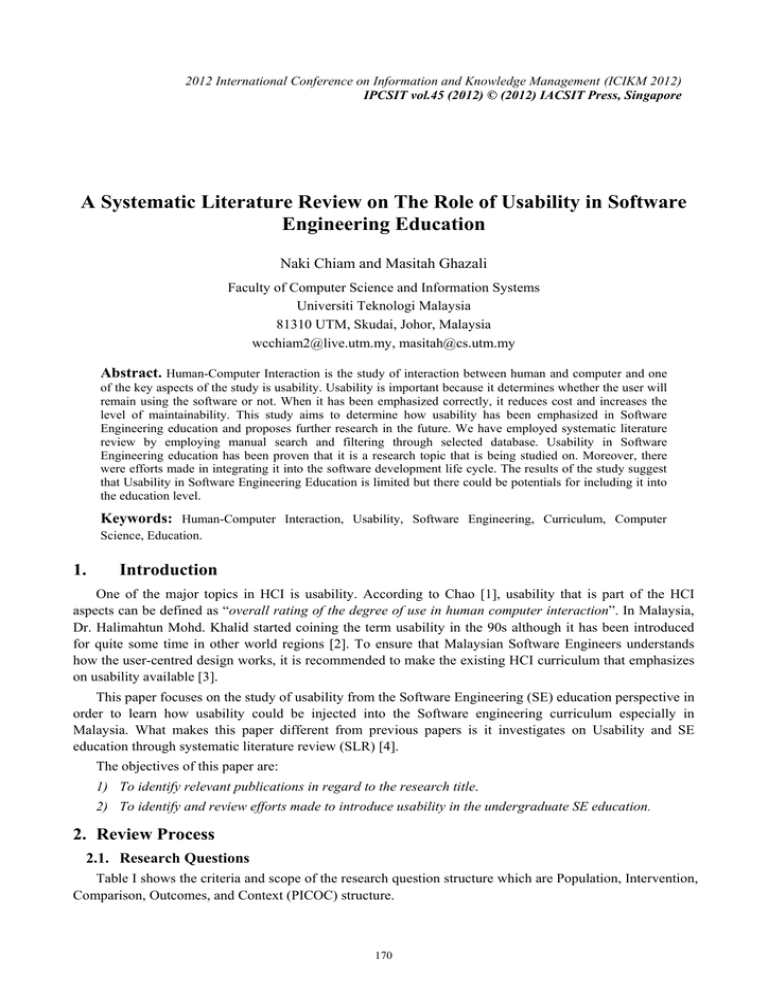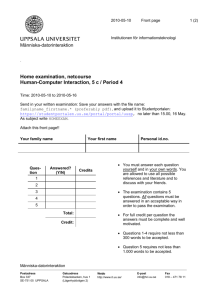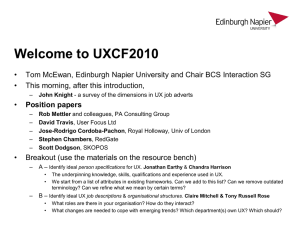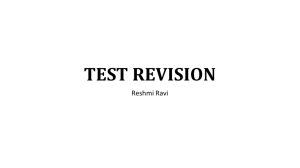A Systematic Literature Review on The Role of Usability in... Engineering Education Naki Chiam and Masitah Ghazali
advertisement

2012 International Conference on Information and Knowledge Management (ICIKM 2012) IPCSIT vol.45 (2012) © (2012) IACSIT Press, Singapore A Systematic Literature Review on The Role of Usability in Software Engineering Education Naki Chiam and Masitah Ghazali Faculty of Computer Science and Information Systems Universiti Teknologi Malaysia 81310 UTM, Skudai, Johor, Malaysia wcchiam2@live.utm.my, masitah@cs.utm.my Abstract. Human-Computer Interaction is the study of interaction between human and computer and one of the key aspects of the study is usability. Usability is important because it determines whether the user will remain using the software or not. When it has been emphasized correctly, it reduces cost and increases the level of maintainability. This study aims to determine how usability has been emphasized in Software Engineering education and proposes further research in the future. We have employed systematic literature review by employing manual search and filtering through selected database. Usability in Software Engineering education has been proven that it is a research topic that is being studied on. Moreover, there were efforts made in integrating it into the software development life cycle. The results of the study suggest that Usability in Software Engineering Education is limited but there could be potentials for including it into the education level. Keywords: Human-Computer Interaction, Usability, Software Engineering, Curriculum, Computer Science, Education. 1. Introduction One of the major topics in HCI is usability. According to Chao [1], usability that is part of the HCI aspects can be defined as “overall rating of the degree of use in human computer interaction”. In Malaysia, Dr. Halimahtun Mohd. Khalid started coining the term usability in the 90s although it has been introduced for quite some time in other world regions [2]. To ensure that Malaysian Software Engineers understands how the user-centred design works, it is recommended to make the existing HCI curriculum that emphasizes on usability available [3]. This paper focuses on the study of usability from the Software Engineering (SE) education perspective in order to learn how usability could be injected into the Software engineering curriculum especially in Malaysia. What makes this paper different from previous papers is it investigates on Usability and SE education through systematic literature review (SLR) [4]. The objectives of this paper are: 1) To identify relevant publications in regard to the research title. 2) To identify and review efforts made to introduce usability in the undergraduate SE education. 2. Review Process 2.1. Research Questions Table I shows the criteria and scope of the research question structure which are Population, Intervention, Comparison, Outcomes, and Context (PICOC) structure. 170 Table I: Summary of PICOC. Criteria Population Intervention Scope Papers proposing model or framework for SE education Usability Comparison None Outcomes Suggest how usability can be injected into SE education Context Usability in SE education Based on the Table 1, the research questions are: [Q1] Did any framework or model was proposed for the SE Curriculum? [Q2] How has Usability been integrated in SE Education? [Q3] How are we going to measure the effectiveness of the usability integration after the study? 2.2. Strategy The complete search string based on Salleh et al. [5] keyed into IEEE Xplore is as followed: (Software Engineering OR SE) AND (Education OR Curriculum OR Syllabus). 2.3. Qualitative Analysis To fasten up the data extraction process, a form has been designed to gather papers related to the research questions and as the study’s qualitative measurement. Table II shows the questions asked while analyzing the papers chosen according to the search string. Table II: Qualitative Analysis Questions Question Q1. Was the article about undergraduate SE curricula? Q2. Was usability or HCI mentioned in the paper? Q3. Did the paper mentioned include measurement the study’s effectiveness? Answer Yes/No Yes/No quantitative Yes/No/Partially Q4. Will the paper contribute to the research conducted? Yes/No/Partially 3. FINDINGS Table III shows results of the search procedure. Initially, we identified 59 papers but after going through the Qualitative Analysis, we have managed to identify only 24 papers relevant to the study. Table III shows the list of selected papers with answers to the questions asked in the Qualitative Analysis. Table III: Systematic Reviews on SE Education ID Author Year Title Type Q1 Q2 Q3 Q4 S1 S2 Barzilay et al. Bourque et al. 2009 2002 Journal Conference Yes Yes Yes No Yes No Partially Yes S3 Ding at al. 2011 Conference Yes No No Yes S4 Frezza et al. 2006 Journal Yes No Partially Yes S5 Garg and Varma 2008 Conference Yes No No Partially S6 2005 Journal Yes No No Yes S7 Hazzan and Tomayko Hazzan A Multidimensional Software Engineering Course Guide to the Software Engineering Body of Knowledge (SWEBOK) and the Software Engineering Education Knowledge (SEEK) - a preliminary mapping Research and practice on software engineering undergraduate curriculum NJU-SEC2006 Creating an Accreditable Software Engineering Bachelor's Program Software Engineering Education in India: Issues and Challenges Reflection and abstraction in learning software engineering's human aspects Putting Human Aspects of Software Engineering in University Curricula Journal Yes No No Yes S8 S9 Katz Lethbridge et al. 2010 2007 Software Engineering Practicum Course Experience Improving software practice through education: Challenges and future trends Journal Conference Yes Yes No No No No No Yes 2010 171 S10 Lethbridge et al. 2006 S11 Mead 2008 S12 Milewski 2004 S13 Parnas 1999 S14 S15 Polack-Wahl Pow-Sang et al. 2004 2009 S16 Pyla et al. 2004 S17 S18 Rusu et al. Shao et al. 2008 2011 S19 Sun 2011 S20 Thompson and Reed Tucker 2005 S22 van der Veer and van Vliet 2001 S23 S24 van Vilet Zeid 2006 2007 S21 3.1. 2002 SE2004: Recommendations for Undergraduate Software Engineering Curricula Software Engineering Education: How Far We've Come and How Far We Have to Go Software engineers and HCI practitioners learning to work together: a preliminary look at expectations Software engineering programs are not computer science programs Journal Yes Yes No Yes Journal Yes No No No Conference Yes Yes No Yes Journal Yes Yes No Yes Teaching HCI in software engineering Applying the Chilean Educational Experience in HCI to Peruvian Undergraduate and Graduate Programs What we should teach, but don't: proposal for a cross pollinated HCI-SE curriculum Conference Conference Yes No Yes Yes No Yes Yes Yes Conference Yes Yes No Yes Usability Practice: The Appealing Way to HCI An introductory software engineering course for software engineering program The challenge and practice of creating Software Engineering curriculum Undergraduate Software Engineering Education: The Mark of a Discipline On the balance between theory and practice [software engineering curriculum] The human-computer interface is the system; a plea for a poor man's HCI component in software engineering curricula Conference Conference No Yes Yes No Yes Yes Partially Partially Conference Yes No No Yes Journal Yes No No No Journal Yes No No Partially Conference Yes Yes No Partially Reflections on software engineering education Lessons Learned from Establishing a Software Engineering Academic Programme in Developing Countries Journal Conference Yes Yes Yes Yes No No Yes Yes Published Year Fig. 1: Number of Publications vs Year. Based on Fig 1, the papers selected laid in between the year 1999 and 2011. There were no papers selected for the year 2000 and 2003. One paper was selected in the year 1999 and 2001. Two papers from the year 2002, 2005, 2007, 2009 and 2010 while 2004, 2006, 2008 and 2011 had three papers from each of the year. The mode for number of publications according to Fig 1 is two papers. On average, 1.85 papers were found per year. 3.2 Relevant Conference or Journal Table IV shows the relevant conference or journal to the study based on Table III. The main source of the papers comes from CSEET since nine publications came from it although conference year varied. IEEE Software has the second highest number of publications by having seven of the papers being listed under it. Out of eight of the sources, three of them were listed under journal type while the rest of it was proceedings. Since this is a Software Engineering curriculum study, it was expected that CSEET to have the highest number of publications. 172 Table IV: Relevant Journals and Conferences Source Acronym Type Computer IEEE Software IEEE Transactions on Education Conference on Software Engineering Education and Training Frontiers in Education Future of Software Engineering IEEE International Magnetics Conference International Conference on Advances in Computer-Human Interaction Computer Software ITEDU CSEET Journal Journal Journal Proceeding Number of Publications 1 7 1 9 FIE FOSE INTERMAG ACHI Proceeding Proceeding Proceeding Proceeding 2 1 1 2 4. DISCUSSION In this section, we discuss the answers to the proposed research questions for this study. [Q1] Did any frameworks or model was proposed for the SE Curriculum? S1, S2, S3, S4, S10 and S14 proposed framework or model with respect to SE education but S1 focused more on the introductory course of Software Engineering and not the curriculum per se. S10 reviewed the curriculum [6] that was used as the reference or guideline for S1, S3, S4, S7, S9, S18 and S20. As for HCIcentered model of framework, S14, S15, S16 and S17 mentioned about applying HCI in the SE curriculum. In S10, there were four different patterns introduced to fit the needs of different type of SE curriculum. In North America and Japan, the SE curriculum have been modified to fit in the four years curriculum where as SE is a three years programme in the UK. [Q2] How has Usability been integrated in SE education? Usability is the subset of HCI and our main focus. It is undeniable that there were attempts where usability has been suggested to be included into the SDLC visibly such as the requirements phase [6, 7] or at the design phase [8] .However, as it has been previously mentioned before, usability should be introduced at the education level [3] particularly SE undergraduate programme. S16 pointed out that in order to integrate Usability Engineering (UE) with SE in non higher education background itself; there were several barriers in combining these two disciplines: • Differences in requirements representation. UE focuses on the visual aspect when it comes to requirements interpretation and SE is more textbased. • Differences in testing. Usability testing tests little by little at every SDLC stage and SE has its own independent stage for testing. • Differences in terminologies. Scenario in SE means how the system will be used and interacts among each other and scenario in UE means story telling or narration. • Dependencies and constraints. Requirements gathered by both sides are different and conflicts might exist between UE and SE. SE is about the functional requirements and UE is hierarchical tasks analysis S17 is about Computer Science in general but it has adapted usability evaluations in its CS curricula as a standard practice for introducing usability or HCI in the early undergraduate level. The same practice was adopted by S15. [Q3] How are we going to measure the effectiveness of the usability integration after the study? S4 mentioned partially or briefly regarding how to measure the effectiveness of the integration through the customized outcomes that will be used later to improve the program’s effectiveness. 173 S17 used feedback from the ex-students and professionals to find out whether or not introduction to HCI should be a compulsory subject. The result was a satisfactory because even the practitioners agreed HCI is important from the industry experience. The clearer picture of the effectiveness was photographed through the implementation of HCI over the course of several years. S15 adopted S17’s practices but it was not measured according to S17’s methodology. It was actually measured through the presentation conducted by the students. S1 was measured through questionnaire and S18 was through the student’s general satisfactory score. 5. Conclusion There is no established study regarding usability injection into the SE curriculum in Malaysia since all the results found are actually from different parts of the world such as China, Peru or Chile [S3, S5, S7]. There is clear evidence that the integration would definitely benefit the students and equip them with the knowledge needed in their future SE practices. Our future research is to identify the current SE curriculum in Malaysia and to propose SE curriculum with usability integrated. 6. Acknowledgement This paper is supported by Universiti Teknologi Malaysia’s GUP grant under the Vote No. Q.J130000.2628.02J78 . Sub-project No. 02J78. We would also like to thank Ministry of Higher Education (MOHE) for the conference opportunity. 7. References [1] C. Gong, “Human-computer interaction: The usability test methods and design principles in the human-computer interface design,” in 2009 2nd IEEE International Conference on Computer Science and Information Technology, 2009, pp. 283-285. [2] A. W. Yeo, P.-chan Chiu, T.-yong Lim, and P.-ping Tan, Global Usability, vol. 1, no. 1. London: Springer London, 2011, pp. 211-222. [3] I. Hussein, M. Mahmud, and A. O. M. Tap, “A survey of usability awareness in Malaysia IT industry,” in 2011 International Conference on User Science and Engineering (i-USEr ), 2011, vol. 1982, no. March 1982, pp. 146151. [4] B. Kitchenham, O. Pearl Brereton, D. Budgen, M. Turner, J. Bailey, and S. Linkman, “Systematic literature reviews in software engineering – A systematic literature review,” Information and Software Technology, vol. 51, no. 1, pp. 7-15, Jan. 2009. [5] N. Salleh, E. Mendes, and J. Grundy, “Empirical Studies of Pair Programming for CS/SE Teaching in Higher Education: A Systematic Literature Review,” IEEE Transactions on Software Engineering, vol. 37, no. 4, pp. 509525, Jul. 2011. [6] T.C. Lethbridge, R. LeBlanc, A. Sobel, T. Hilburn, and J. Díaz-Herrera, J., “SE 2004: Recommendations for Undergraduate Software Engineering Curricula”, IEEE Software, Nov-Dec 2006, pp. 19-25. [7] O. Dieste and N. Juristo, “Systematic review and aggregation of empirical studies on elicitation techniques,” IEEE Transactions on Software Engineering, vol. 37, no. 2, pp. 283-304, Mar. 2011. [8] N. Juristo, A. M. Moreno, and M.-I. Sanchez-Segura, “Analysing the impact of usability on software design,” Journal of Systems and Software, vol. 80, no. 9, pp. 1506-1516, Sep. 2007. 174





